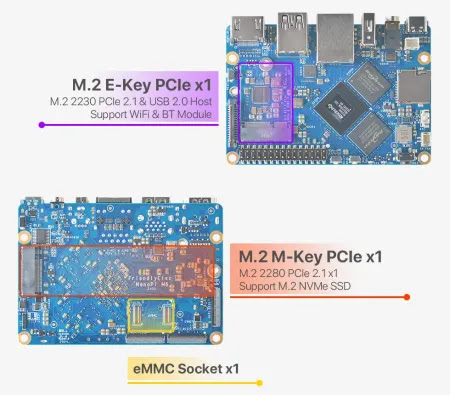The NanoPi M6 is a compact, open-source single-board computer (SBC) designed to deliver high performance, making it a compelling option for various applications. Powered by the Rockchip RK3588S System-on-Chip, it offers a robust feature set that caters to both hobbyists and developers.
Powerful Performance and Expandability
The NanoPi M6's core lies in the Rockchip RK3588S SoC. This powerful chip integrates a quad-core ARM Cortex-A76 and a quad-core Cortex-A55 CPU, paired with the Mali-G610 MP4 GPU, ensuring efficient graphical processing. With up to 32GB of LPDDR5 RAM at 2400MHz, the NanoPi M6 delivers the necessary horsepower to handle demanding tasks.
Storage options are plentiful, with an eMMC flash socket and a microSD card slot for expandable storage. Moreover, the NanoPi M6 features an M.2 Key-M socket for PCIe storage, allowing for high-speed SSD integration. Additionally, an M.2 Key-E socket provides flexibility for adding Wi-Fi or Bluetooth connectivity via PCIe or USB.
Comprehensive Connectivity and Multimedia Capabilities
The NanoPi M6 boasts a wide array of connectivity options, including three USB ports and a native Gigabit Ethernet port powered by the RTL8211F chip. This ensures seamless communication and networking capabilities.
Multimedia capabilities are also impressive, with support for video decoding at up to 8K resolution. It handles H.265/VP9 formats at 60 frames per second and H.264 at 30 frames per second. The HDMI output, compatible with HDMI 2.1, 2.0, and 1.4, supports resolutions up to 7680 x 4320 at 60Hz and 10-bit RGB/YUV formats.
Two 4-lane MIPI-DSI interfaces facilitate display output, while two 4-lane MIPI-CSI interfaces provide video input capabilities, expanding the NanoPi M6's potential for multimedia projects.
Operating System Flexibility and Customization
FriendlyElec, the company behind the NanoPi M6, offers support for a diverse range of operating systems, including Android, Debian, Ubuntu, and FriendlyWrt. This caters to both headless and display-based configurations, giving users freedom in choosing the operating system that best suits their needs. While the NanoPi M6 is not currently supported by lightweight operating systems like Armbian or DietPi, the company's commitment to open source suggests future support for these options is possible.
Custom Case and LCD Integration
FriendlyElec provides a custom CNC metal housing for the NanoPi M6. This enclosure enhances the board's aesthetics and durability. Notably, it incorporates a built-in 3.5-inch capacitive touchscreen LCD with a resolution of 480×800, adding an interactive element to the NanoPi M6 experience.
Specifications and Pricing
The NanoPi M6 offers a compelling combination of features and affordability. The base model, featuring 4GB of RAM, is priced at $70. Users can opt for 16GB of RAM for an additional $30 or 32GB for $80 more. The board can be purchased standalone or bundled with accessories such as the metal case for an extra $20 or the metal case with the LCD for $45 more. eMMC storage modules are available separately, with a 32GB module priced at $8 and a 64GB module at $10.
Conclusion
The NanoPi M6 presents itself as a versatile and powerful SBC that caters to a wide range of applications. Its powerful hardware, extensive connectivity options, and support for multiple operating systems make it an ideal choice for developers, hobbyists, and makers seeking a robust platform for their projects. Whether you're building a media center, creating a custom embedded system, or experimenting with robotics, the NanoPi M6 offers a compelling foundation for your endeavors.
The availability of a custom metal case and integrated LCD further enhances the NanoPi M6's appeal. Its compact size, efficient performance, and open-source nature make it a compelling option for individuals looking to unleash their creativity in the realm of embedded computing.






0 comments:
Post a Comment